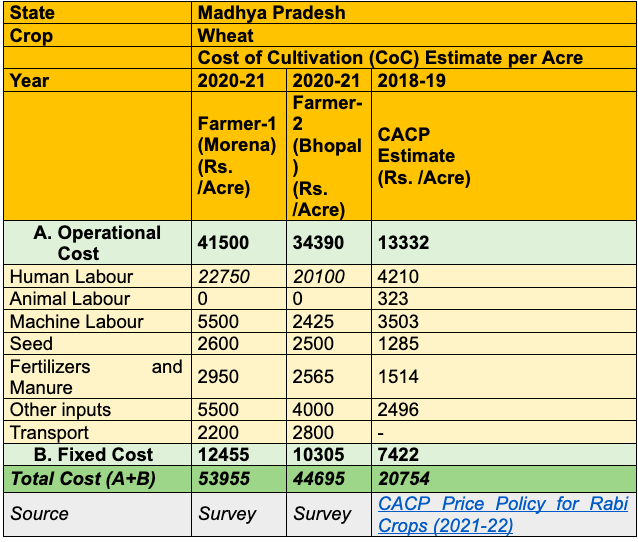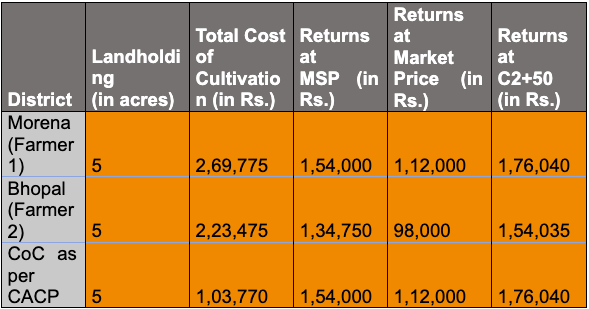‘We Will Become Slaves’: The Economics of Small Farmers in Madhya Pradesh
On being asked about how the new Farm Laws would affect him, Naresh Singh Tomar, a small farmer from the village of Thua Kheda in Bhopal district responded in an agitated tone: “We will not make any profit by selling our produce to private traders. It is the government that ensures that private traders pay us for our produce in the mandis. In the absence of mandis, baniyas (private traders) will pay us at arbitrary prices.”
Balwan Tomar, another small farmer from Thua Kheda, asked: “Where will we go to sell our produce if not to mandis? Who will pay the transportation costs? Farmers will become slaves,” he added.
Each of them owns about five acres of land. Elaborating on their financial situation, they explained how small farmers have been struggling as the returns they get for their produce are not even enough to meet their cost of cultivation. Most of them do not keep a record of their expenditure. A common assertion by small and marginal farmers from Madhya Pradesh was that “the moment we start keeping a record of our expenses and costs, we will not be able to continue with farming!”
Low returns for their produce is a major factor pushing farmers into an economic crisis and indebtedness. This is brought out in conversations with farmers from the districts of Morena and Bhopal. A comparison with the cost of cultivation (CoC) for wheat, as projected by the Central Government’s Commission of Agricultural Costs and Prices (CACP) in its Price Policy Report (2021-22), shows that the actual costs are far greater than the government’s estimates. Notably, it is this CoC estimate which is the basis for declaring Minimum Support Prices (MSPs).
The MSP for wheat for the Rabi Marketing Season (RMS) 2020-21 was Rs 1,925/quintal. Despite Madhya Pradesh’s large share in the country’s wheat procurement, farmers do not seem to benefit from selling at MSP. Farmers from the districts of Sehore, Bhopal, Bhind, Morena, Datiya and Gwalior reported that they mostly end up selling their produce to private traders as the machinery for government procurement is very tedious. All India Kisan Sabha (AIKS) joint secretary Badal Saroj explained: “Not even 10% of farmers sell their produce to the government through the mandis. The produce is bought by arthiyas (middlemen) who then sell it to the mandis.”
The price at which small and marginal farmers from MP reported selling their produce to private traders was barely between Rs 1,300 and Rs 1,400/quintal, which is between 27% to 32% less than the MSP (Rs 1m925/quintal). Due to the low prices offered to them, most farmers asserted that they found it difficult to meet their cost of cultivation. They managed to make ends meet by working as agricultural labours, construction workers and doing other menial jobs. According to Agriculture Census Data 2015-16, small and marginal farmers constitute 75.57% of agricultural households in MP.
The following table shows the break-up of the CoC incurred by farmers from Morena and Bhopal – both small farmers with landholdings of five acres each. The table also compares the CoC reported with estimates of CoC for MP as projected by the CACP for 2018-19.
Table 1

In the above table, human labour includes family labour (labour by family members of the landholder) and wage labour by agricultural labourers. Given the small size of the landholdings, most of the cultivation activity in both cases were carried out by family members. Wage labour was employed in activities like harvesting, threshing, cleaning and transportation. The wage rate for agricultural labour reported by farmers from across the state is Rs 300 per day.
Ploughing and sowing was done using tractors. While Farmer 1 hired a tractor, Farmer 2 owned one. As reflected in the table, the CoC is reduced in case of ownership of agricultural machinery.
The category labelled ‘other inputs’ includes irrigation charges, insecticides etc. Irrigation charges depend on the source of water for irrigation and the resources spent on irrigation activity, largely electricity charges. These charges are reduced in case of ownership of bore-well and subsidies on electricity. Transportation costs are significant if the farmer has to travel long distances to sell their produce. The CACP calculation does not include transportation costs in its estimate of CoC. Fixed cost includes the rental value of owned land (in case of ownership of cultivated land), land revenue and taxes, depreciation on implements and farm buildings and interest on fixed capital.
Table 1 clearly shows that the total CoC per acre, as reported by farmers from Morena (Rs. 53,955/acre) and Bhopal (Rs. 44,695/acre), is more than double of that estimated by CACP (Rs. 20,754/acre). The total CoC for Farmer 1 and Farmer 2 are 160% and 115% higher than the CoC estimates by CACP.
While making this comparison, one needs to bear in mind that the CACP projections in consideration are from the year 2018-19 (the latest available) and the costs narrated by the farmers interviewed are from the year 2020-21. However, the difference between the costs is so significant that factoring in rates of inflation for two years will not make much of a difference to the huge gap we speak of.
According to data in Table 1, cost estimates by CACP under most heads are close to 50% of the cost estimates from the survey, except in case of machinery and human labour. The estimates for the cost of human labour under the CACP estimates are about one-fifth of the cost estimates from the survey. Clearly, human labour is significantly undervalued in the CACP estimates of CoC.
As reported by farmers, the maximum wheat production from one acre of land in case of a successful crop is 20 quintals. The MSP and market price for wheat are Rs 1,925 per quintal and Rs 1,400 per quintal respectively. CACP also calculates Comprehensive cost (C2) for different crops every year. C2 includes imputed costs of family labour, imputed rent of owned land and imputed interest on owned capital. In 2006, the Swaminathan Commission recommended that the farmers be paid 50% over the C2 calculated by CACP as MSP (C2+50). This has also been a core demand of the farmers ever since. According to the CACP Price Policy report (2021-22), C2 projection for wheat for Rabi crop season 2019-20 is Rs 1,467/quintal.
In case of a successful crop (20 quintals/acre), the total produce for each of the farmers on their land (five acres each) will be 100 quintals. Out of this total produce, Farmer 1 and Farmer 2 reserve 20 and 30 quintals respectively for themselves for the year. Their marketable surplus comes down to 80 quintals and 70 quintals respectively. For the sake of comparison, let us consider a marketable surplus in case of CoC estimates by CACP to be 80 quintals.
The following table shows a comparison between the total CoC incurred by the two farmers interviewed on their land and the total returns they would receive at MSP, market price and C2+50 in case of a successful crop (20 quintals/acre).
Table 2

Table 2 shows that even at MSP, the returns that the farmers receive are significantly lower than their cost of cultivation. Even at Swaminathan Commission’s MSP (C2+50), the Farmer 1 stands to suffer a loss of 35% and Farmer 2 a loss of 31%. At market price – if CoC calculated by CACP is considered – the returns will result in a profit of eight per cent. This is far from the on-ground reality where, on selling their produce at market price, farmers from Morena and Bhopal stand to suffer a loss of 58% and 56% respectively.
The above data reflects the dire situation that small farmers find themselves in. Hardly able to meet their cost of cultivation, they are forced to borrow at every step. This has resulted in farmers drowning under the burden of indebtedness – debt from banks, co-operative societies and money lenders. Their condition is expected to worsen even further with the introduction of the new Farm Laws. The farmers will now be competing in open markets, battling market fluctuations. Public procurement of their produce will go down even further.
Rajesh Sharma, a member of AIKS from Bhind district in Madhya Pradesh, said: “According to a government report, there is a farm suicide every 17 minutes in our country. Government reports state that only six per cent of farmers sell their produce at MSP in the country. Rather than stressing on this, the report should have stressed on how to stop farmers’ suicides and how to ensure that 100% of the farmers sell their produce at MSP.”
“If they had passed a law to ensure this, the entire country would have welcomed it. But the laws brought about by PM Narendra Modi will destroy the people of the country, and the people of Madhya Pradesh in particular.” A small farmer with a landholding of five acres, Sharma is at the Palwal Border where farmers from Madhya Pradesh have come together to demand the repeal of the Farm Laws.
The writer is an author and a researcher with Tricontinental: Institute of Social Research. The views are personal. She can be reached on Twitter @ShinzaniJain.
Get the latest reports & analysis with people's perspective on Protests, movements & deep analytical videos, discussions of the current affairs in your Telegram app. Subscribe to NewsClick's Telegram channel & get Real-Time updates on stories, as they get published on our website.














